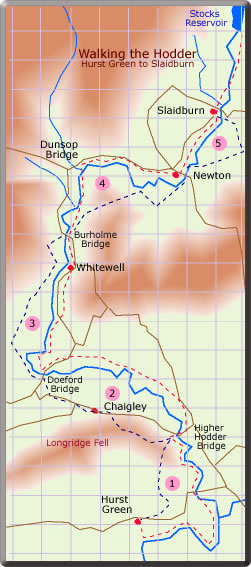
The
pack horse bridge built by
Sir Richard Shireburn in 1562
still stands -
as viewed from Lower Hodder Bridge.
Sir Richard Shireburn in 1562
still stands -
as viewed from Lower Hodder Bridge.
As the crow flies the distance from Slaidburn to Hurst Green is 9 miles, the Hodder however meanders some 19.5 miles from Stocks Reservoir until it meets the Ribble.
 The Lower Hodder between Higher and Lower Hodder Bridges marks the historical county boundary between Lancashire and Yorkshire.
The Lower Hodder between Higher and Lower Hodder Bridges marks the historical county boundary between Lancashire and Yorkshire. The object of this series of
walks is to explore the Hodder from Hurst Green in the south
to Slaidburn or Stocks Reservoir in the north. It is not possible to follow the
banks of the Hodder wholly along public footpaths, so some diversion
has to be made. The route has been divided into 5 stages; each
stage made into a circular walk with a pub as a possible objective.
The completion of these stages enables the whole of the Hodder
to be explored.
The object of this series of
walks is to explore the Hodder from Hurst Green in the south
to Slaidburn or Stocks Reservoir in the north. It is not possible to follow the
banks of the Hodder wholly along public footpaths, so some diversion
has to be made. The route has been divided into 5 stages; each
stage made into a circular walk with a pub as a possible objective.
The completion of these stages enables the whole of the Hodder
to be explored. Walk details for each stage can
be found by clicking the respective link below or on the map.
Walk details for each stage can
be found by clicking the respective link below or on the map. It is essential to use the O.S map for each walk which may be printed off from the respective web page.
It is essential to use the O.S map for each walk which may be printed off from the respective web page.Stage 1 - from Hurst Green to Higher Hodder Bridge.
Stage 2 - from Higher Hodder Bridge to Doeford Bridge
Please note that since this route was first described some paths have become overgrown. Parts of the walk may now be found to be too difficult.
Stage 3 - from Doeford Bridge to Burholme Bridge
Stage 4 - from Burholme Bridge to Newton
Stage 5 - from Newton to Slaidburn and beyond

Walking the Hodder

The plot shows the height profile for the River Hodder starting at its confluence with the River Ribble on the left and its exit from Stocks Reservoir top right. The water falls through 135 m/443 feet over its meandering course of 19.5 miles. The 5 stages described in the walks above and points of interest along the River are shown on the diagram.
The plot was produced using Google Maps Pro.
The name Hodder is likely derived from Brythonic. Its meaning is either "pleasant stream" or possibly "boundary"
(Welsh yr odre), the latter suggesting that the Lancashire/Yorkshire border has its origins in the depths of antiquity. It is thought that Bowland takes its name from the Old Norse boga- meaning a bow in a river; the Hodder being characterised by the way it meanders and twists through the Bowland landscape.
River Hodder Ref.:Wikipedia®
River Hodder Ref.:Wikipedia®